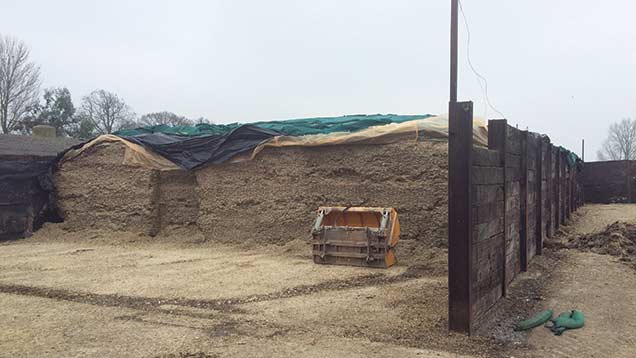Save clamped maize and turn cows out early

Dairy farmers faced with bulging maize clamps and good spring grass growth should look at resealing their maize clamps and turning cows out early.
See also: Tips on selecting with forage maize variety to grow
That’s the advice from Neil Groom, technical director for forage specialists Grainseed, who says keeping cows in to use up the surplus forage will be a very expensive option.
“Grazed grass is still the most cost-effective feed for producing milk. If you don’t get cows out early this year, grass growth could overtake you, making management difficult in the coming months.”
Good maize growing conditions in 2014 mean many farms produced about 20-25% more maize than usual and Mr Groom estimates half of UK producers have several hundred tonnes of really good-quality material still in the clamp.
A combination of good grass growing conditions, soil temperatures at about 6-7C and dry conditions allowing many to get their slurry on promptly means that early turnout could be on the cards for many.
Mr Groom says: “If you can see three leaves, your cows should be out and for many this means turning out in early April rather than mid-April. For others it could be a full month earlier.”
See also: Replacing wholecrop and barley with betamaize
But producers deciding to turn out early need to decide what to do with their surplus maize. Mr Groom says the decision depends on farmers’ milk-supply profile and location.
“If you’re in the East, where summer grass growth is hit and miss, buffer feeding is an obvious option, but for most, using it as an autumn ‘super forage’ would be preferred.”
Clamp management
Clamps need to be managed carefully over the next few weeks to achieve this, Mr Groom warns.
“Many people haven’t even opened their second clamp yet so if it’s in sound condition you can just leave it.
“For others two-thirds their way through a big clamp, I would move it to a smaller clamp if possible – it takes time but means your main storage is available for this year’s crop.
“Fortunately maize re-clamps really well – use thin layers and roll it well just as you would with fresh crop.”
Producers with neither of these options should carefully reseal the existing clamp, he advises.
“Get the clamp face as tidy as you can, spray it with a chemical additive and bring the plastic sheet down as tightly as possible.
“Use a layer of gravel bags at the base of the plastic and on the top leading edge and make sure you exclude all the air you can.”
Hampshire-based independent dairy nutritionist Martin Attwell says maize saved this way will make the perfect early autumn forage.
“There’s a strong argument for feeding 15-20kg/day of the surplus as a buffer to balance the 24-25% crude proteins we expect to see in early spring fresh grass.”
See also: Select premium maize variety for 10% more yield
But keeping the majority back for the autumn will be a real bonus for cows as forage analyses show maize improves all the time it is in the clamp, he says.
“We did tests in November 2014 on maize that showed 71-75% starch degradability and the same material now is testing at 78-79%.”
Feeding this rather than fresh maize will benefit both freshly calved cows and close-to-calving dry cows this autumn, he explains.
“It has a much higher feeding value than freshly ensiled maize and you’ll be able to get more energy into your cows at a vital time when they need it.”
Mr Groom says producers should see the extra forage as a bonus and an opportunity to add some stability to their businesses.
“It’s a fortuitous set of circumstances that could really benefit producers, but we certainly wouldn’t advise cutting back on forage production in 2015.
“You never know what is around the corner, as the past few years have shown.”
